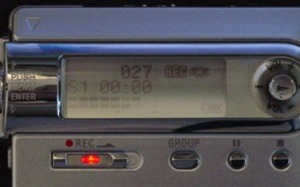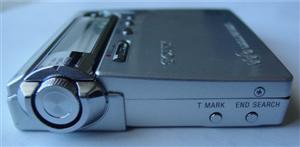|
N10 Review Index: Home In the box/Specs Design User Interface Remote Control General Operation NetMD/SonicStage 1.5 Final Thoughts |

Previous Page :: [page 4] :: Next Page User Interface The key buttons for controlling the unit are located on the face of the unit. A 5-way joystick sits to the right of the LCD, which controls playback, tracking, and volume (to start playback, you push the joystick straight in, like a button). The design of the N10's joystick is a vast improvement of the MZ-N1's control bar, where trying to push the bar straight in was rather hit-and-miss. The N10's controller design makes it much easier to push the controller in the desired direction.
The N10 is equipped with a 3-line LCD on the face of the unit (almost identical to the N1's LCD) which effectively displays all of the vital info such as track/disc/folder names, playing time, battery life (4-step indicator), and level meters. Like the N1 and R909, the N10 has separate 9-step level meters for the left and right channels. And like the N1, by default the level meters occupy a very tiny space under the 3rd text line of the LCD; however during recording, the entire 3rd text line of the display is dedicated to displaying the left/right input levels, while 2 small dots under the line mark the -12db and "OVER" markers.
Each line of the text display is 9 characters long. When a title extends past the end of the display, it will scroll across (or rather, "stutter" across) the display; if there is more than one title on the LCD (for instance, disc title AND track title) in the current display mode, then the titles will take turns scrolling (for instance, disc title will scroll once, stop, then the track title will scroll once, stop, disc title will scroll again, etc.) One thing that struck me immediately was the poor contrast level of the LCD. The readability/contrast on the main unit's LCD was a bit of a disappointment; if you can't tell from these pictures, the text on the LCD is rather dim, and changing the contrast level does not seem to really help much. The readability is still adequate for most situations, but when compared side-by-side with the previous N1, the display's contrast on the N10 leaves something to be desired. A backlight on the main unit would have been extremely nice, but even on their 10th anniversary model Sony didn't give us that. Oh well...
The redesigned jog-dial/knob now sits on the left-hand side of the unit, and operates in much the same way as on previous Sony units. By default, scrolling the dial allows you to browse the tracks on the disc (even during playback), and pushing the jog dial back (from the face-side of the unit towards the backside of the unit, and not into the unit from the left side) will enter the command. The jog-dial clicks softly as you scroll it, and it scrolls at a linear rate (meaning if you scroll the knob continuously, the scrolling does not speed up... this isn't really necessary in any case with the N10 as the menus are not really that long). Pushing the jog dial in without first scrolling it will enter you into the menu system; you can then use the STOP button as a "back" button, and use the dial to navigate the menus. The Sony engineers have streamlined the menus a bit from the N1, making them slightly easier to navigate. Still the vast depth of menu options may be a dream to MD fanatics, it can also be slightly intimidating for the less-tech-savvy user at first.
Below is a rundown of the vast menu system for both the main unit, and the wired remote control.
Remote Control Menu chart
|



